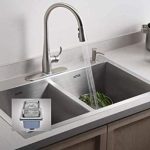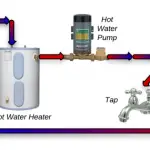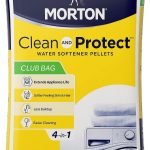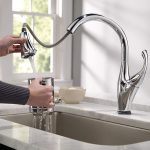Water softeners were created for solving one common problem – the hard water in one’s home. The hard water conditions can be quite annoying. They can even be quite destructive. If you want to keep the hard water away from your home, one of the most essential aspects that you need to focus on is to look for how much salt to put in the water softener. Let us try finding the complete details on how much salt should you add to your water softener.
The water softener would ideally require 30 to 80 pounds of salt per month. The standard size of the water softeners will have a salt storage tank that can hold up to 200 pounds of salt. They would ideally need to be refilled every 6 to 8 weeks.
How Much Salt to Put in Water Softener?
The brine solution is one of the necessary parts of the ion exchange process and that is what would store your salt which acts as the agent that softens your water. The amount of salt that needs to be added to the water softener will be largely dependent on the size of the brine tank.
It is possible to have both too much and too little salt in your water softener. To help you keep your water softener working at its maximum capacity and efficiency. This will help you maintain the proper amount of salt in the tank.

It is advisable to keep the brine tank at least one-quarter full. It should also be taken care to see that he salt level should not exceed 4 to 6 inches below the top. Moreover, the salt level should always stand a few inches above the water level.
How Many Bags of Salt to Fill Water Softener?
A properly sized water softener will require around 40 pounds bag of salt per month. This calculation is based on the average-sized water softener that is designed for a family of four and a water hardness level of 7 to 10 grains per gallon.
The average-sized home with an average family size of people with four members will need to have a usage of around 10 pounds of salt per week. The best option would be check your water and salt level in the tank at the beginning of every month. It would be advisable to check out the backwash frequency and salt dose recommendations and you would also need to check out the regeneration cycle as outlined in the manual that came with your water softener.
Tips for Adding Salt to Your Brine Tank
When you are adding salt to your brine tank, it is advisable to check out the best tips that you would find much more practical.
Break up the salt
Before adding the salt to your brine tank, it may be advisable to break up and loosen the salt and its particles. You will need to break the salt inside the tank with a broom. It would be ideal to break up the salt to avoid the formation of lumps.
Check the encrusted salt
If you find any encrusted salt on the sides of the tank, it is a good option to break it and remove It should ideally fall to the tank and break up the large pieces of the salt to loosen it up.
Remove salt bridge if any
Salt bridges that form inside a brine tank can be something that can be extremely annoying and disturbing. It affects the proper functionality of your water-softening process very dearly. Observing the brine tank for any signs of salt bridges would be the ideal solution to help you address the concern.
Use the proper salt
Use the proper water softener salt. It should be noticed that the salt you use should be compatible with your brine tank in particular and water softener in general. Never use a regular salt, but ensure using the right quality of salt in tune with whether your water softener is made for potassium chloride or sodium chloride.
Adjust the Salt As Per Your Needs
It is expected that your water softener will ideally need you to add around 40 pounds of salt per month. However, there are possibilities that would help you adjust the amount of salt that can be added to the brine tank.
The ideal conditions that you would need to adjust the salt as per your different needs would be when you have a larger capacity of the brine tank, or perhaps you have a very high level of hardness of water. Yet another reason can be that your water supply has a higher iron content.
Types of Salt Used for Water Softener
The exact amount of salt used in a water softener would largely be dependent on the type of salt used. The highest level of purity is what would make the best option to use in a water softener. The salt that consists of higher levels of impurities or water-soluble ingredients can cause the build-up of the green substance or other issues in the tank.
- Rock salt: Lowest level of purity is what makes the salt less impurity-filled option.
- Solar salt: This is 99.6% pure salt. But you cannot use it with the high hardness of water
- Evaporated salt: This is the purest form of salt and it is 99% of purity. It is the right pick for the human consumption
- Crystal salt: Crystals have the highest chance of leaving unwanted residue. You will need to clean it frequently.
- Pellets: This is one of the most used forms of salt In a water softener. They do not leave any residue as such.
- Blocks of salt: Block salts are never recommended for use in a water softener. It is the least efficient and leaves your tank requiring frequent cleaning.
A Few FAQs
The Concluding Thoughts
Using the right type of salt would be much needed for an efficient water-softening process. It is also advisable to know a lot about how much salt to put in the water softener. A water softener is indeed an expensive investment and you would find it a great option and you would find all the more unique in every right.












Add Comment